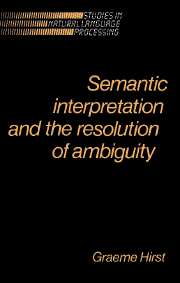4 - Lexical disambiguation
Published online by Cambridge University Press: 18 December 2009
Summary
There's no need to think, dear. Just do what's in the script, and it'll all come out right.
—Alfred HitchcockWhat is necessary for lexical disambiguation?
The problem of determining the correct sense of a lexically ambiguous word in context has often been seen as one primarily of context recognition, a word being disambiguated to the unique meaning appropriate to the frame or script representing the known or newly-established context. For example, in the well-known SAM program (Cullingford 1978, Schank and the Yale AI Project 1975, Schank and Abelson 1977), each script has associated with it a set of word meanings appropriate to that script; in the restaurant script, there will be unique meanings given for such words as waiter and serve, and when (4-1) is processed:
(4-1) The waiter served the lasagna.
the fact that serve has quite a different meaning in the tennis script will not even be noticed (Schank and Abelson 1977:183). (Certain words naming well-known people and things, such as Manhattan, are always present (Cullingford 1978:13).)
In its most simple-minded form, the script approach can easily fail:
(4-2) The lawyer stopped at the bar for a drink.
If only the lawyering script is active, then bar as an establishment purveying alcoholic beverages by the glass will be unavailable, and its legal sense will be incorrectly chosen. If resolution is delayed until the word drink has had a chance to bring in a more suitable script, then there will be the problem of deciding which script to choose the sense from; as Charniak (1984) points out, it is reasonable to expect in practice to have fifty or more scripts simultaneously active, each with its own lexicon, necessitating extensive search and choice among alternatives.
- Type
- Chapter
- Information
- Semantic Interpretation and the Resolution of Ambiguity , pp. 77 - 95Publisher: Cambridge University PressPrint publication year: 1987

